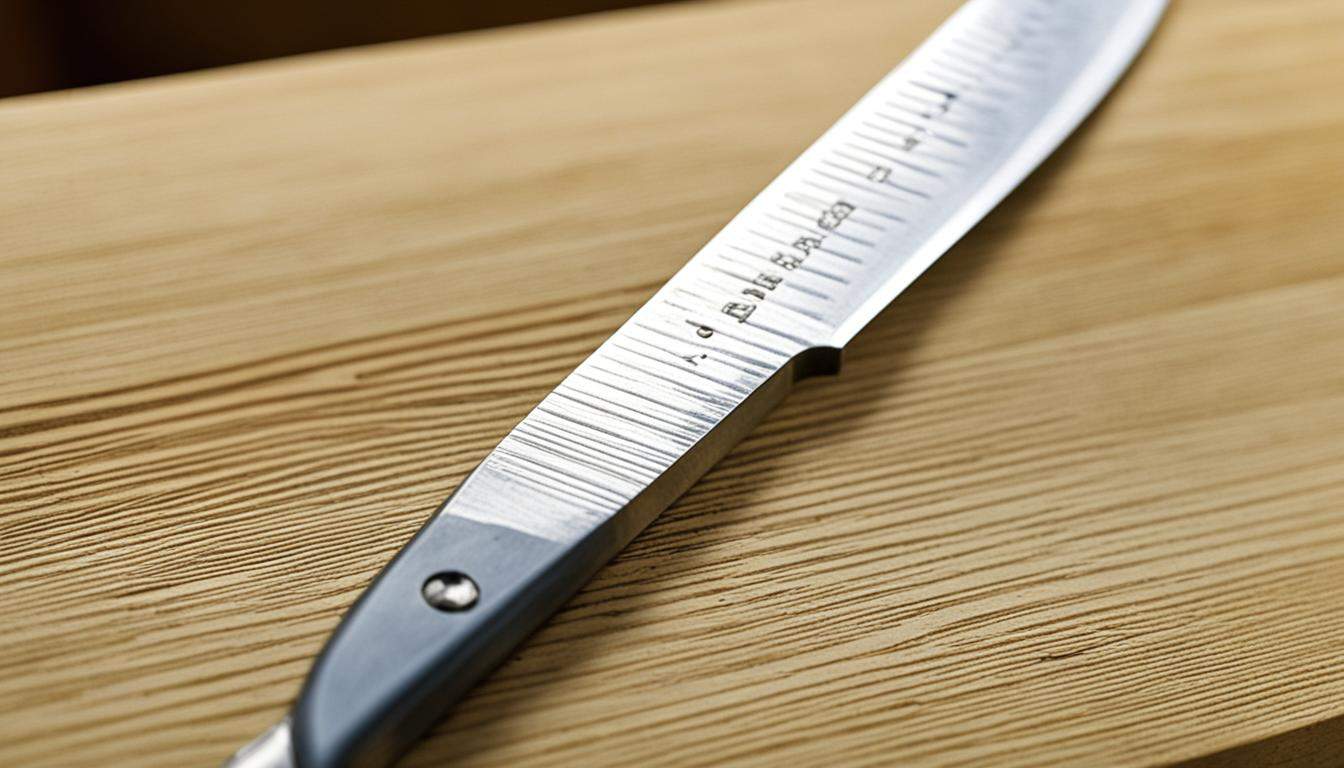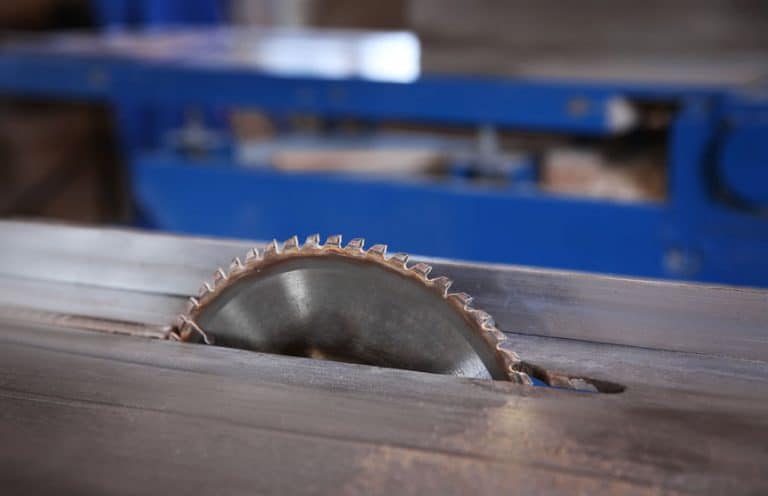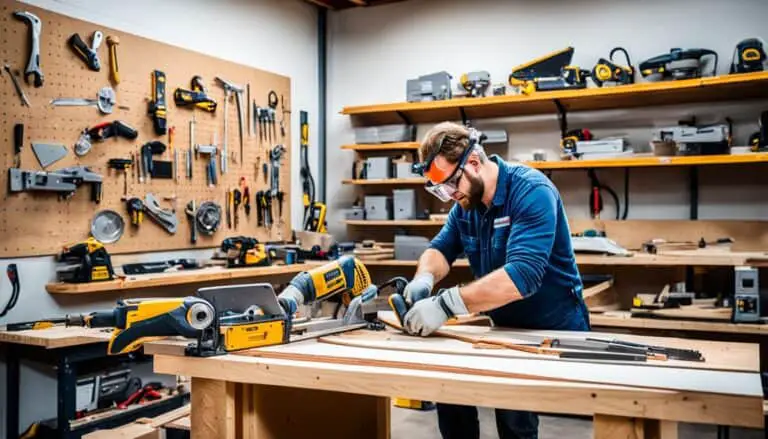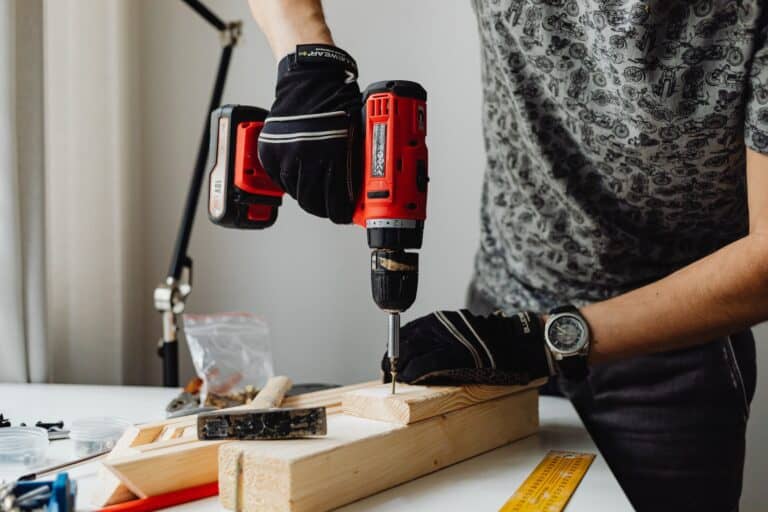Finding the right marking knife for precision woodworking can be a challenge. In this article, we will explore some of the top options available, as recommended by experts in the field. Whether you are working on delicate dovetails or large-scale projects, having a reliable and accurate marking knife is essential for achieving woodworking accuracy.
Key Takeaways:
- Using a marking knife ensures precision and accuracy in woodworking projects.
- Consider the type of woodworking you do when choosing a marking knife.
- Experts recommend Japanese knives and Chris Vesper knives for precision woodworking.
- Marking knives can be used for joinery, layout lines, and other woodworking techniques.
- Maintain and sharpen your marking knife regularly for optimal performance.
The Importance of a Marking Knife in Woodworking
A marking knife is an essential tool for any woodworker. It allows for precise and accurate layout of cuts, joinery, and other markings on wood. Unlike pencils or pens, a marking knife creates a clean and crisp line that is easy to follow and guarantees accuracy. Whether you are creating intricate dovetails or simply marking out the dimensions for a project, a marking knife ensures that your cuts are precise and fit together seamlessly.
With a marking knife, you can achieve woodworking accuracy by creating clear guidelines for your cuts. The thin and sharp blade of the knife allows you to scribe lines with precision, ensuring that your cuts are made exactly where they need to be. This level of accuracy is crucial, especially when working on sensitive or intricate projects.
Another advantage of using a marking knife is that it eliminates the guesswork when making cuts. Pencil lines can be easily smudged or faded, leading to inaccurate cuts and ill-fitting joints. A marking knife, on the other hand, creates a permanent groove in the wood, providing a foolproof guide for your saw or chisel.
Furthermore, a marking knife allows you to create layout lines that are visible even on dark or rough wood surfaces. The sharpness of the knife’s blade ensures that the markings stand out, making it easier to follow your layout and achieve the desired results.
“A marking knife is like the precision scalpel of woodworking. It enables you to make surgical, accurate cuts that result in seamless joinery and impeccable craftsmanship.”
Benefits of Using a Marking Knife:
- Precision: The sharp blade of a marking knife ensures accurate markings, resulting in precise cuts and tight joinery.
- Clarity: Marking knives create clean lines that are easy to follow, eliminating guesswork and ensuring woodworking accuracy.
- Long-lasting: Unlike pencils or pens, markings made with a marking knife are permanent and do not smudge or fade over time.
- Visibility: The crisp lines created by a marking knife are visible even on dark or rough wood surfaces, allowing for easier layout and execution.
Investing in a high-quality marking knife is a wise decision for any woodworker. It is a versatile tool that improves woodworking accuracy, enhances the quality of your craftsmanship, and enables you to tackle a wide range of projects with confidence.
Factors to Consider When Choosing a Marking Knife
When it comes to choosing a marking knife for your woodworking projects, there are several important factors to consider. The right marking knife can make a significant difference in the accuracy and precision of your cuts. Here are some key considerations to keep in mind:
Type of Woodworking
First and foremost, think about the type of woodworking you will be doing. If you primarily work on delicate projects such as dovetails or inlays, a finer-tipped marking knife would be the ideal choice. The fine tip allows for more precise and intricate markings, ensuring that your cuts are spot on. On the other hand, if you work on larger-scale projects that require heavier marking, a sturdier knife with a thicker blade would be more suitable. This will ensure that the markings are visible and durable even on rougher surfaces.
Handle Design and Comfort
The handle design of a marking knife plays a crucial role in your overall comfort and control while using the tool. Look for a handle that is ergonomic and fits comfortably in your hand. A well-designed handle will improve your grip and reduce hand fatigue during extended periods of use. Additionally, consider the material of the handle. Wood, plastic, or composite materials can all provide different levels of durability and comfort, so choose one that suits your preferences and needs.
Quality and Durability
Investing in a high-quality marking knife is important for long-lasting performance. Look for a knife made from high-quality materials that will not only withstand heavy use but also maintain its sharpness over time. A well-constructed marking knife will have a durable blade that holds its edge, allowing for consistent and accurate markings. Consider brands and models that are known for their craftsmanship and positive reviews from other woodworkers.
A well-chosen marking knife will not only enhance your woodworking accuracy but also make your projects more enjoyable. By considering the type of woodworking, handle design, and the overall quality and durability of the knife, you can make an informed decision that meets your specific needs.
Next, let’s take a closer look at some recommended marking knives by experts in the field.
Recommended Marking Knives by Experts
When it comes to precision woodworking, experts in the field have recommended a variety of marking knives. These tools are essential for achieving accurate and clean markings in your woodworking projects. Whether you’re a professional or a hobbyist, choosing the right marking knife is crucial for achieving woodworking accuracy. Let’s take a look at some top recommendations from experts.
Japanese Marking Knife:
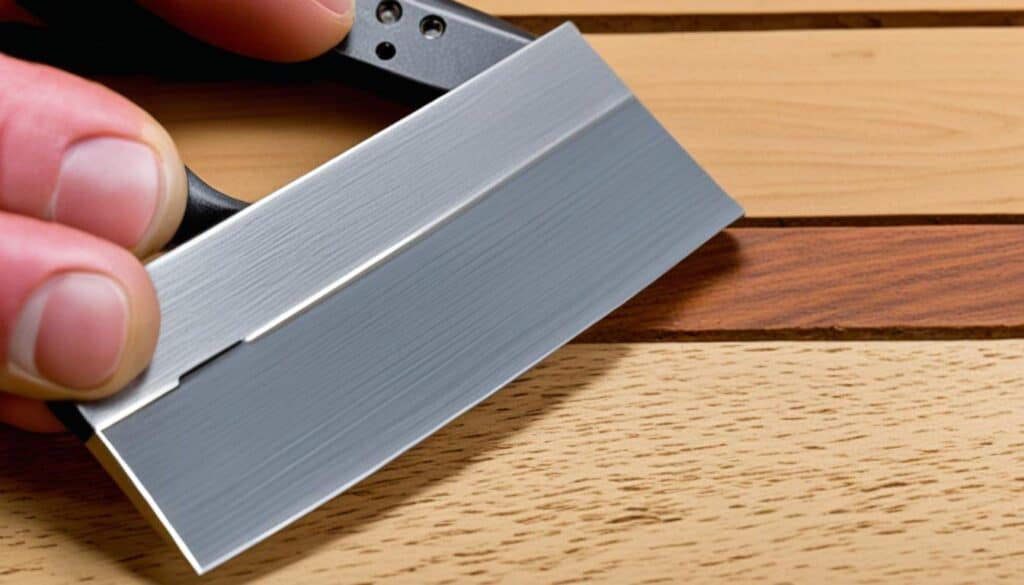
One popular option recommended by experts is the Japanese marking knife. Known for its sharpness and durability, this knife creates clean and precise markings on wood. With its fine-pointed blade and ergonomic design, it offers great control and accuracy for delicate woodworking tasks.
Chris Vesper Marking Knife:
“The Chris Vesper marking knife is a top choice for fine woodworking. Its heavy-duty design and exceptional craftsmanship make it a reliable tool for precision work.”
Renowned in the woodworking community, the Chris Vesper marking knife is a favorite among experts. This knife features a sturdy construction that ensures longevity and delivers accurate markings. With its comfortable grip and well-balanced design, it offers excellent control for intricate woodworking tasks.
Swann-Morton Disposable Knives:
If you are looking for a disposable option that’s easy to resharpen, experts recommend Swann-Morton knives. These knives provide sharp and durable blades that can be replaced when needed. They are ideal for both fine detail work and larger-scale projects where precision is key.
Stanley Folding Pocket Knife:
“I’ve been using the Stanley folding pocket knife for years, and I find it to be an excellent marking tool. It’s compact, easy to carry, and provides precise markings.”
Renowned woodworker Paul Sellers highly recommends the Stanley folding pocket knife for marking tasks. With its foldable design, this knife offers convenience and portability without compromising on accuracy. It’s a versatile tool that can handle a wide range of woodworking projects.
By considering the recommendations from experts, you can find a marking knife that suits your specific needs and ensures precise and accurate markings in your woodworking endeavors.
Using a Marking Knife for Different Woodworking Techniques
A marking knife is a versatile woodworking tool that serves various functions and techniques in the craft. Its sharp and precise edge allows for clean and accurate markings on wood, making it an indispensable tool for any woodworker seeking precision and consistency in their projects.
One of the primary uses of a marking knife is for marking out joinery, such as dovetails and mortise and tenons. By using a marking knife, woodworkers can create precise and accurate cuts, ensuring a tight and seamless fit for their joinery. The thin and sharp blade of the marking knife creates a clean and crisp line, allowing for precise cutting along the marked edges.
Additionally, a marking knife is ideal for marking the dimensions of a project. Whether you need to mark specific measurements for a cut or layout lines for a design, a marking knife ensures accuracy. Its sharp point and clear marking make it easy to follow the lines and achieve the intended results.
Creating Perfect Layout Lines
When it comes to layout work, a marking knife is the tool of choice for many woodworkers. Its fine point allows for precise and clear layout lines, ensuring accuracy throughout the project. Whether you are marking out the location of holes, intricate details, or any other necessary layout lines, a marking knife provides the precision you need.
Furthermore, a marking knife can also be used as a skew chisel for specific woodworking tasks. By manipulating the knife at an angle, woodworkers can create beveled edges or chamfers on their workpiece. This versatility gives a marking knife an added advantage over other tools, making it a valuable addition to any woodworker’s toolkit.
A marking knife is an essential precision marking tool that allows for clean and accurate markings in woodworking. From marking out joinery to setting dimensions and acting as a skew chisel, a marking knife offers versatility and precision in various woodworking techniques.
Using a marking knife requires some skill and practice to ensure optimal results. It’s essential to hold the knife firmly but lightly, allowing for precise control. Remember to maintain a consistent pressure while marking to create visible grooves without going too deep.
| Technique | Benefits |
|---|---|
| Marking out joinery | Precision and accuracy in cuts |
| Marking dimensions | Accurate measurements and layout lines |
| Acting as a skew chisel | Versatility in woodworking tasks |
By incorporating a marking knife into your woodworking process, you can achieve clean, accurate, and professional-looking results. Whether you are a beginner or an experienced woodworker, a marking knife is an invaluable tool that enhances precision and elevates your craft.
Tips for Sharpening and Maintaining a Marking Knife
Keeping your marking knife sharp is essential for achieving accurate markings in woodworking. A dull blade can lead to imprecise lines and compromised woodworking accuracy. To ensure that your marking knife is always in optimal condition, follow these tips for sharpening and maintenance:
Sharpening Your Marking Knife
- Use a honing guide or wooden jig to hold the knife at the correct angle during sharpening. This helps maintain consistency and ensures that the bevels are honed evenly.
- Gently rub the blade against a sharpening stone or hone, moving it in a back-and-forth motion. Start with a coarse grit and gradually progress to finer grits for a polished edge.
- Avoid applying too much pressure while sharpening to prevent damage to the blade or uneven bevels.
- Regularly check the sharpness of the blade and sharpen as needed to maintain a keen cutting edge.
Note: If you are new to sharpening tools, consider practicing on a spare blade or seeking guidance from experienced woodworkers.
Maintaining Your Marking Knife
- Clean the blade after each use to remove any wood residue or debris. Wipe it with a clean cloth or use a brush to gently scrub off any stubborn particles.
- Avoid using harsh chemicals or abrasive materials that can damage the blade or handle. A mild soap and water solution should be sufficient for cleaning.
- Dry the blade thoroughly to prevent rust or corrosion. Consider applying a thin layer of oil or a rust inhibitor to further protect the blade.
- Inspect the handle for any signs of wear or damage. Tighten any loose fittings or replace the handle if necessary.
Note: Proper maintenance not only prolongs the life of your marking knife but also ensures optimal performance and woodworking accuracy.
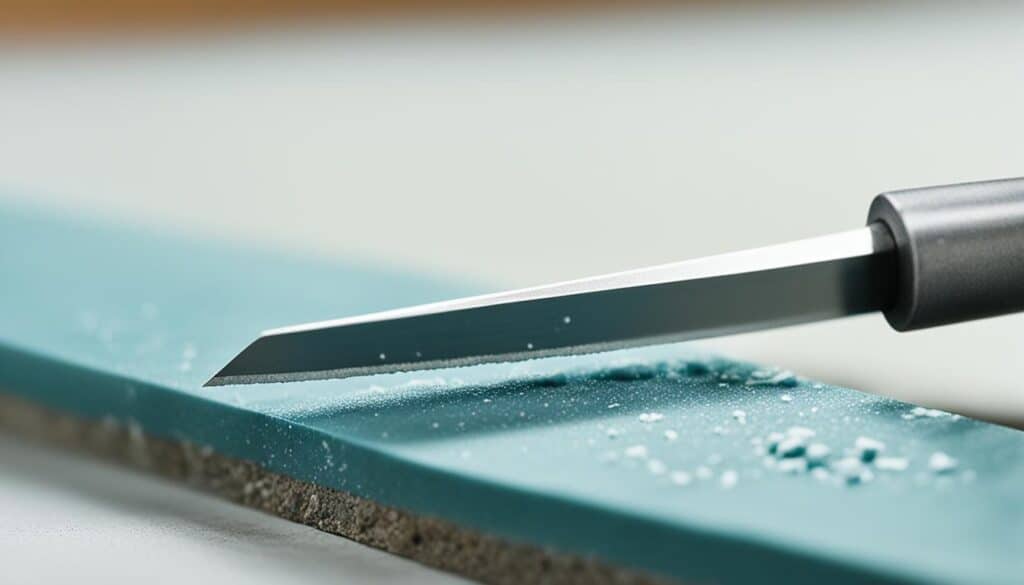
| Benefits of Sharpening and Maintenance | Consequences of Neglecting Sharpening and Maintenance |
|---|---|
|
|
DIY Marking Knife Options
If you prefer a more personalized approach, you can also create your own marking knife. Many woodworkers have had success using modified box cutters or repurposed blades from old tools. By shaping the blade and adding a comfortable handle, you can create a custom marking knife that suits your specific needs. DIY marking knives can be a cost-effective option and allow for a unique tool that you have crafted yourself.
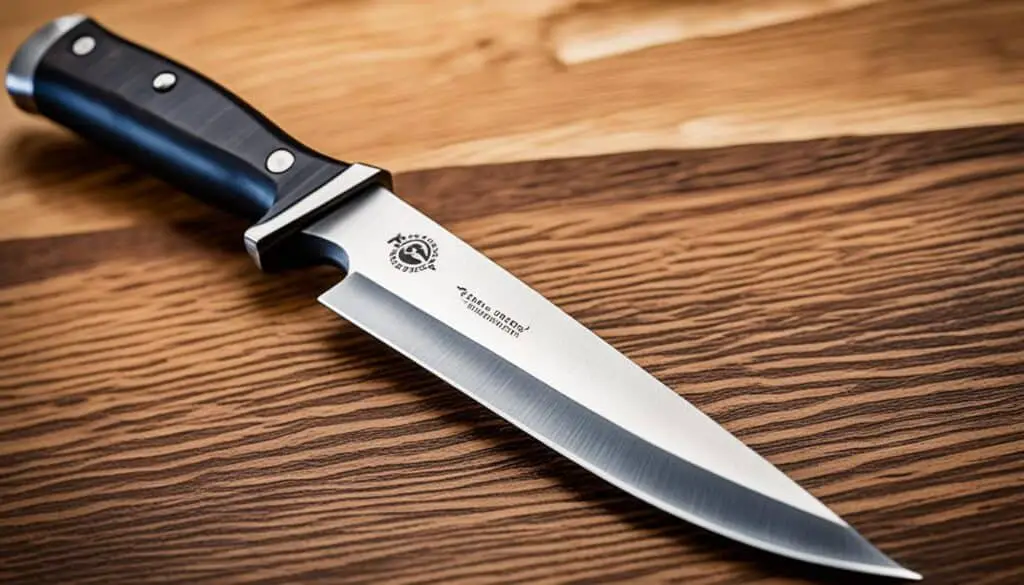
Benefits of DIY Marking Knives
Creating your own marking knife can offer several advantages. Firstly, it allows you to customize the blade and handle to perfectly fit your hand and working style. You can shape the blade to your preferred shape and size, whether it’s a fine tip for delicate work or a broader edge for heavier marking. Additionally, by repurposing old blades, you can save money while still creating a functional and reliable marking knife.
DIY marking knives offer woodworkers the opportunity to have a tool that is unique to their workshop. By putting in the effort to create your own marking knife, you can develop a deeper connection with the tool, enhancing the overall woodworking experience.
Step-by-Step Guide to Creating a DIY Marking Knife
If you’re interested in making your own marking knife, here’s a simple step-by-step guide to get you started:
- Choose a suitable blade: Look for an old box cutter or utility knife blade that can be modified for marking purposes. Ensure that the blade is in good condition and has the desired length.
- Shape the blade: Use a grinder or file to shape the blade according to your needs. Consider the type of woodworking you’ll be doing and the specific markings you’ll need to make.
- Create a handle: Select a piece of wood or other suitable material for the handle. Carve or shape the handle to be comfortable and ergonomic, ensuring a secure grip during use.
- Attach the blade: Once the handle is complete, carefully attach the shaped blade to the handle using epoxy or strong adhesive. Ensure that the blade is securely fastened and aligned with the handle.
- Finishing touches: Sand the handle and blade to smooth any rough edges. Apply a protective finish to the handle to enhance durability and longevity.
DIY Marking Knife Example
Here’s an example of a simple DIY marking knife:
| Blade Material | Handle Material | Blade Type |
|---|---|---|
| Recycled utility knife blade | Carved wooden handle | Fine tip |
This DIY marking knife offers a cost-effective solution for precision marking in woodworking projects. The recycled blade ensures a sharp cutting edge, while the carved wooden handle provides a comfortable grip. The fine tip allows for precise markings on delicate projects.
The Pros and Cons of Different Marking Knife Designs
Different marking knife designs have their own advantages and disadvantages. When choosing a marking knife design, it’s important to consider your specific woodworking needs and preferences. Let’s explore the pros and cons of three popular designs: traditional English-style marking knives, Japanese knives, and folding pocket knives.
Traditional English-Style Marking Knives
Traditional English-style marking knives are known for their reliability and durability. Made with high-quality materials, these knives can withstand heavy use and are built to last. They have a robust construction, making them suitable for demanding woodworking tasks. However, their wider blades may lack the precision required for finer details.
Japanese Knives
Japanese knives are highly praised for their sharpness and precision. They are expertly crafted with fine blades that excel at creating clean and accurate markings. Japanese knives are especially suitable for intricate woodworking projects that require delicate and precise lines. However, their sharpness means they may need more frequent sharpening to maintain their performance.
Folding Pocket Knives
Folding pocket knives offer convenience and portability. With their compact size, they can be easily carried in your pocket or toolbox, allowing for quick access when needed. These knives are versatile and can be used for various tasks beyond marking in woodworking. However, folding pocket knives may not provide the same level of precision as dedicated marking knives due to their folding mechanism.
When choosing a marking knife design, consider the level of detail required in your woodworking projects, the durability needed for the tasks at hand, and the portability factors that suit your working style. Evaluating these factors will help you select the marking knife design that best fits your specific needs.
Now that you have a better understanding of the pros and cons of different marking knife designs, you can make an informed decision based on your woodworking requirements and personal preferences.
Marking Knives vs. Other Marking Tools
When it comes to marking tools for woodworking, the marking knife stands out as a versatile and precise option. Unlike traditional pencils or pens, a marking knife offers unique advantages that make it an essential tool in any workshop. Let’s explore how marking knives compare to other marking tools and why they are a preferred choice for woodworkers.
The Advantages of Marking Knives
Marking knives, such as scribe tools or layout knives, have distinct qualities that set them apart from other marking tools. The thin and sharp blade of a marking knife allows for more precise and accurate lines, which are crucial for clean and tight joinery. With a marking knife, you can create crisp and defined markings that ensure a perfect fit for your woodworking projects.
Unlike pencils or pens, marking knives do not smudge or fade over time. The lines made by a marking knife are permanent, making them ideal for long-lasting markings that won’t diminish over the course of a project. This is especially important when working with wood, where precision and durability are key.
Furthermore, marking knives are suitable for marking various materials, including wood, metal, and plastic. This versatility makes them a valuable tool for any woodworking project, as they can be used across different materials without compromising accuracy or quality.
Comparing Marking Knives to Other Marking Tools
Let’s take a closer look at how marking knives compare to other commonly used marking tools:
| Marking Tool | Advantages |
|---|---|
| Pencils | Easy to use, but can produce thicker and less precise lines. Smudging and fading over time can lead to inaccuracies. |
| Pens | Offers more precision than pencils, but the lines may still be thicker than those created by marking knives. Ink can also smudge or fade. |
“A marking knife allows for greater accuracy and cleaner lines compared to pencils or pens. Its thin and sharp blade creates precise markings that do not smudge or fade.”
Considering the advantages mentioned above, it’s clear that marking knives provide superior accuracy and durability compared to other marking tools. Whether you’re working on delicate projects or larger-scale woodworking, a marking knife will consistently deliver the precision you need.
In conclusion, marking knives are an essential woodworking tool that offers exceptional precision and versatility. Their ability to create clean and accurate lines without smudging or fading makes them indispensable for achieving fine woodworking results. If you’re looking for a marking tool that guarantees precise markings and long-lasting accuracy, a marking knife should be at the top of your list.
Tips for Using a Marking Knife Effectively
To use a marking knife effectively, it’s important to follow some key tips. Here are some guidelines to help you achieve woodworking accuracy with your craft knife:
- Keep your blade sharp: A sharp blade is crucial for clean and accurate markings. Regularly sharpen your marking knife to maintain its cutting edge.
- Hold the knife firmly but lightly: Grip the handle firmly for control, but be gentle with your pressure. This allows for precise movements and reduces the risk of slipping.
- Press with enough pressure: When making a mark, apply enough pressure to create a visible groove on the wood. However, be careful not to go too deep, as it can affect the overall accuracy of your cuts.
- Practice on scrap wood: Before working on your actual project, practice using the marking knife on scrap wood. This helps you develop your technique and become more comfortable with the tool.
By following these tips, you can enhance your woodworking accuracy and make the most out of your marking knife.
Example
“A sharp marking knife ensures precise layout lines, which are crucial for accurate joinery. Hold the knife firmly but lightly and press it with enough pressure to create a visible groove. With practice, you’ll master the art of using a marking knife effectively.”
Comparing Different Marking Knife Techniques
| Technique | Advantages | Disadvantages |
|---|---|---|
| Marking Knife |
|
|
| Pencils |
|
|
| Chalk Line |
|
|
Safety Considerations When Using a Marking Knife
While marking knives are valuable woodworking tools, it’s essential to prioritize safety when using them. By following these safety guidelines, you can protect yourself and prevent accidents or injuries:
- Keep your fingers and hands away from the blade: The sharp edge of a marking knife can cause severe cuts. Always be cautious and maintain a safe distance from the blade when using the knife.
- Use a proper grip: Hold the marking knife firmly but comfortably. A secure grip ensures better control and minimizes the risk of accidents.
- Avoid applying excessive pressure: Marking knives don’t require excessive force to make accurate markings. Apply just enough pressure to create a visible groove without going too deep, reducing the likelihood of accidental slips or injuries.
- Store the marking knife securely: After use, store the marking knife in a secure location, such as a dedicated storage box or rack. Keeping it out of reach of children and away from other tools prevents unintentional mishaps.
Remember, safety should always be a priority when working with any woodworking tool, including marking knives. By adopting safe practices, you can enjoy the craft without compromising your well-being.
Cleaning and Maintenance Tips for Your Marking Knife
Proper cleaning and maintenance are essential for prolonging the life of your marking knife. By following these tips, you can ensure that your woodworking tool remains in excellent condition for accurate and precise markings.
Cleaning
After each use, take the time to clean your marking knife properly. Use a clean cloth or towel to wipe down the blade, removing any debris or residue that may have accumulated during the woodworking process. This step is crucial to maintain the sharpness and effectiveness of your marking knife.
Tip: Avoid using harsh chemicals or abrasive materials when cleaning your marking knife. These can potentially damage the blade, compromising its performance.
Maintenance
Regular maintenance is key to keep your marking knife in optimal condition. Here are some maintenance tips:
- Check the sharpness of the blade: A dull blade won’t provide accurate markings. Regularly inspect the sharpness of your marking knife, and if needed, sharpen it using appropriate tools and techniques.
- Sharpening the blade: When sharpening your marking knife, ensure that you maintain the correct angle on both sides of the blade. This will result in a sharp edge that delivers precise markings.
- Storage: Store your marking knife in a dry and safe place to prevent rust or corrosion. Consider using a protective sheath or case to keep the blade in optimal condition.
A well-maintained marking knife will serve you well in your woodworking projects, providing you with the accuracy and precision needed for professional results.
Keep your marking knife clean and well-maintained to ensure accurate and precise markings.
Conclusion
A marking knife is an invaluable tool for precision woodworking. It allows you to create clean and accurate markings, ensuring that your cuts and joinery fit together seamlessly. Whether you prefer a traditional English-style knife, a Japanese knife, or a custom DIY option, finding the right marking knife for your needs and preferences is crucial.
When choosing a marking knife, consider factors such as the type of woodworking you do. If you work on delicate projects like dovetails, a finer-tipped knife may be ideal. For larger-scale projects that require heavier marking, opt for a sturdier knife with a thicker blade. Additionally, pay attention to the handle design, overall quality, and durability of the knife.
Proper maintenance is essential to keep your marking knife in optimal condition. Regularly clean the blade after each use, avoiding harsh chemicals or abrasive materials that can damage it. Maintain the sharpness of the blade through regular sharpening, ensuring precise markings every time. Store your marking knife in a dry and safe place to prevent rust or corrosion.
With the right marking knife and attention to detail, you can achieve accurate and precise markings in all your woodworking projects. Invest in a high-quality marking knife, maintain it properly, and let it become an indispensable tool in your fine woodworking arsenal.
FAQ
What is a marking knife?
A marking knife is a woodworking tool used for precise and accurate layout of cuts, joinery, and other markings on wood. It creates a clean and crisp line that is easy to follow and guarantees accuracy.
What factors should I consider when choosing a marking knife?
When choosing a marking knife, consider the type of woodworking you will be doing, the handle design and comfort, and the overall quality and durability of the knife.
Can you recommend some marking knives?
Some recommended marking knives for precision woodworking include the Japanese knife, the Chris Vesper knife, the Swann-Morton knives, and the Stanley folding pocket knife.
How can I use a marking knife in woodworking?
A marking knife is commonly used for marking out joinery, such as dovetails and mortise and tenons, as well as marking project dimensions and creating layout lines.
How do I sharpen and maintain a marking knife?
To sharpen a marking knife, use a honing guide or wooden jig to hold the knife at the correct angle. Regular maintenance includes cleaning the blade and oiling it for optimal performance.
Can I create my own marking knife?
Yes, you can create your own marking knife by modifying box cutters or repurposing blades from old tools.
What are the pros and cons of different marking knife designs?
Traditional English-style marking knives are reliable but may lack finer detail capabilities. Japanese knives are sharp but may require more frequent sharpening. Folding pocket knives offer convenience but may not have the same precision as dedicated marking knives.
How does a marking knife compare to other marking tools?
Marking knives offer advantages such as creating more precise and long-lasting lines compared to pencils or pens. They are also suitable for marking on various materials like wood, metal, and plastic.
What are some tips for using a marking knife effectively?
Ensure the blade is sharp, hold the knife firmly but lightly, and apply enough pressure to create a visible groove without going too deep.
What safety precautions should I take when using a marking knife?
Keep your fingers and hands away from the blade, use a proper grip, and avoid applying excessive pressure to prevent accidents or injuries.
How should I clean and maintain my marking knife?
After each use, wipe down the blade with a clean cloth, avoid using harsh chemicals or abrasive materials, regularly check the sharpness of the blade, and store it in a dry and safe place.
Can you summarize the importance of a marking knife in woodworking?
A marking knife is essential for achieving woodworking accuracy. It allows for precise layout of cuts, joinery, and other markings, ensuring clean and accurate results in your woodworking projects.


